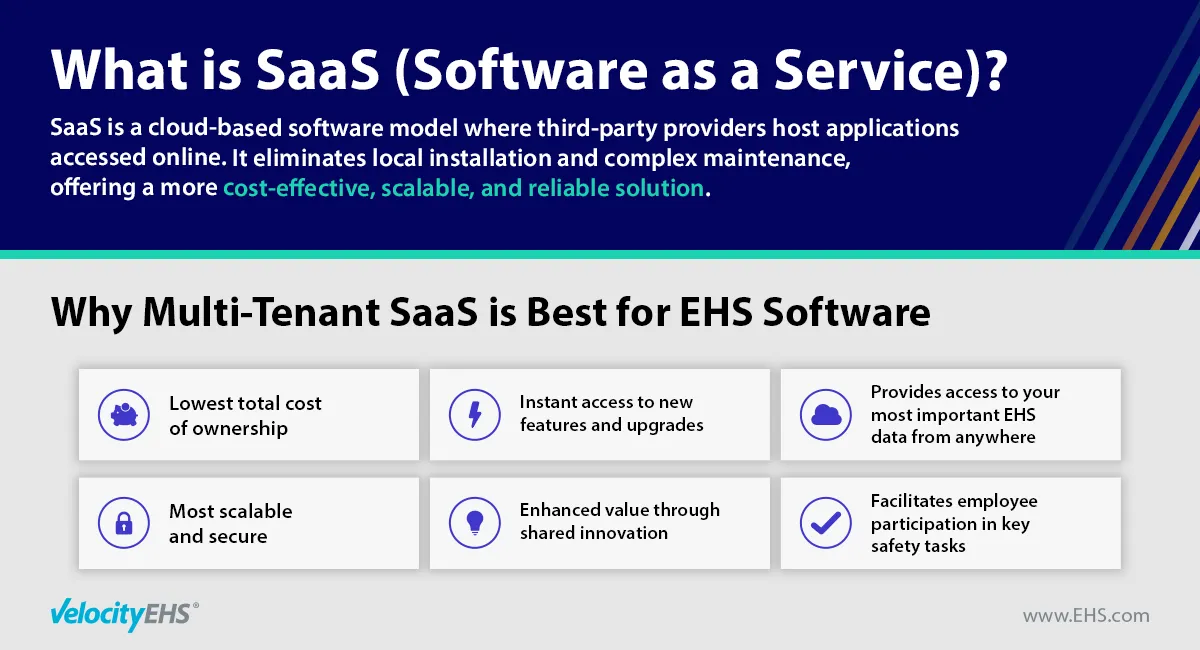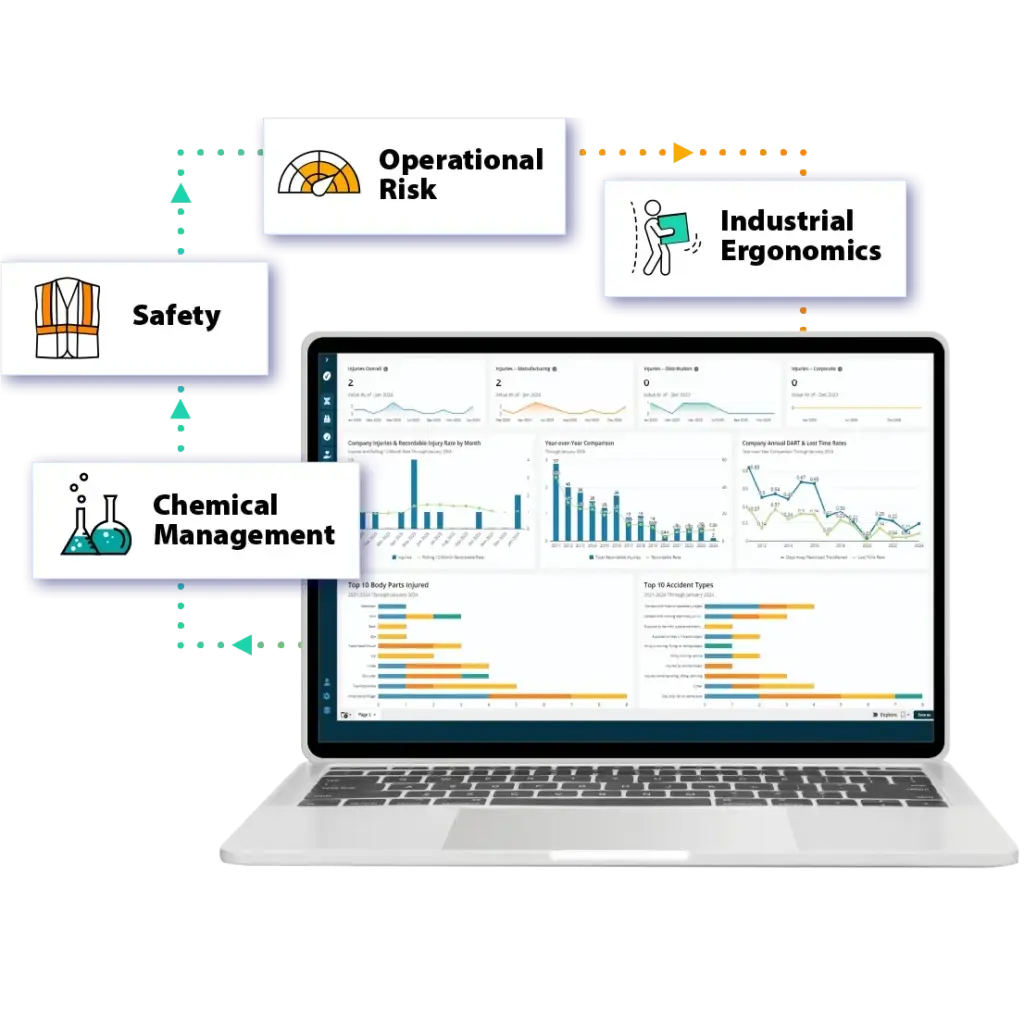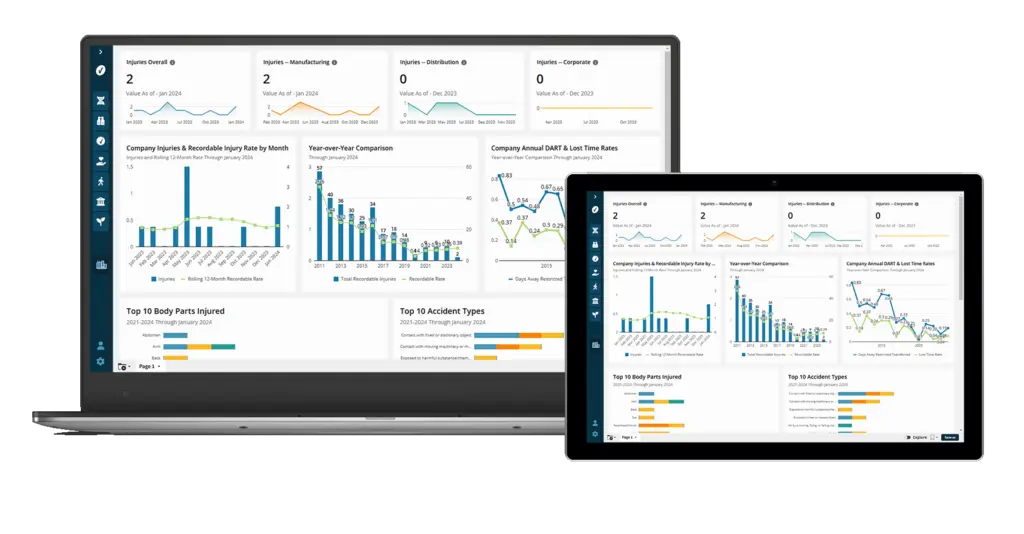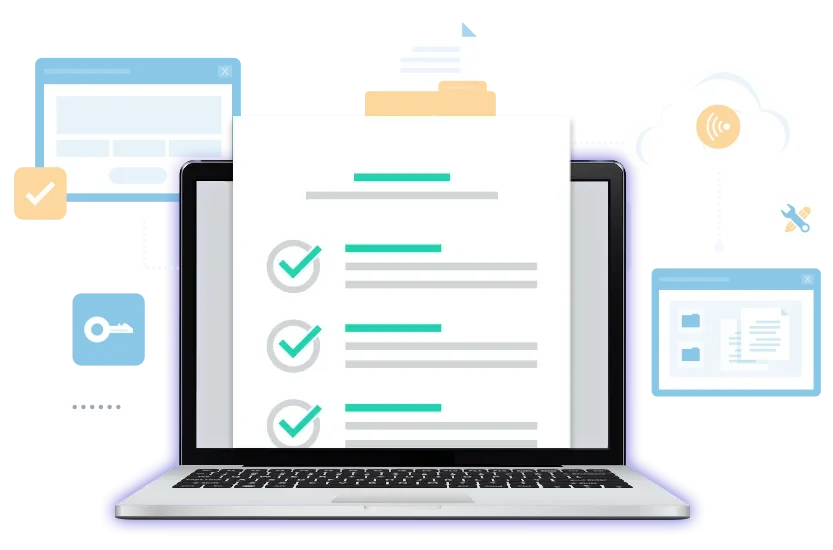EHS Software Buyer’s Guide
Are you looking for EHS Software? Here’s where to start.
Are you in the market for EHS management software and curious about what exactly it is and how it can help? Explore the following topics to learn more.
-
Starting your Software Search
-
What does EHS Software do?
-
What kinds of EHS Software Systems are there?
-
What is Software as a System (SaaS), and what are its benefits?
-
What’s the difference between customization and configuration of EHS Software?
-
What Are Artificial Intelligence (AI) and Machine Learning (ML)?
-
What is Mixed Authentication?
-
What are the benefits of an EHS Software Platform?
-
Get going quickly with the VelocityEHS Accelerate Platform
Starting Your Software Search
You may have already done some internet searches before the one that brought you here and landed on a page by Capterra, G2 or Sourceforge ranking different providers. If so, you’ve likely encountered long lists of seemingly disparate EHS software providers like this:
- VelocityEHS
- Intelex
- Enablon
- Sphera
- Cority
- Vector Solutions
- EHS Insight
- KPA Flex
- Sitedocs
- HIS Donesafe
The information you initially found might feel like a good starting point, but there are a couple of problems you’ll likely find once you start poking below the surface. “Ranking” sites like Capterra and G2 don’t always make it easy for you to understand how they are ranking different software providers – which is a problem because most providers are ranked according to the amount of money they’ve paid the company running the website to show up on the list.
A ranking may be influenced by the number of reviews a respective software company has on the website but does not necessarily consider the actual functionality of the software and the viability of the vendor. Almost none of these websites do the due diligence themselves to dig into the software and to test it out or to help you understand whether the capabilities a software company provides are the ones it should provide.
The related problem is that while many software providers are undoubtedly good at something, the thing they’re good at might not be the most important thing, which is providing EHS professionals like you and your teams with the specific support you really need to help your team be great at EHS.
How do we know that? Because at VelocityEHS, we have been in the EHS software space for a very long time – over four decades, in fact. We listen to and collaborate with EHS professionals like you, and count some of the biggest companies in the world among our customers, like Microsoft, Kraft Heinz, 3M, Ashland Global, and Coca-Cola.
Major software third party analyst Verdantix has also named VelocityEHS as a Leader in their Green Quadrant for EHS software, giving us the highest scores for Safety, Ergonomics, and Chemical Management. In fact, not that we’re counting, but we’ve now been named a leader by Verdantix for the fifth consecutive report.

In other words, wherever you might’ve gone looking for answers about EHS software before, congratulations, because you’ve finally made it to the right place.
Perhaps you’ve wondered if software can help your business reduce workplace safety risks, manage regulatory compliance, and follow industry best practices. Spoiler alert: The answer to all of those questions is “Yes.” But the catch is that you have to understand what to look for in EHS software to be able to get the support you need, and you especially need to know what to look for in 2025, because the EHS software space has come a long way in recent years.
Don’t worry – the information you’re looking for is right here. In what follows, you’ll learn the basics about EHS software in 2025. At any point in your reading, you should also feel free to jump straight over to our VelocityEHS Accelerate® Platform page to request a meeting to see how our software gives you just the support you’re looking for.
Shopping for Chemical Management Software in 2025? Download our Chemical Management Buyer’s Guide today to learn what you need to know before you purchase.
What Does EHS Software Do?
Let’s start with a very basic question: What does EHS software do, or help its users to do?
In short, it helps you to manage your to-do list. If you’re an EHS professional, you already know that’s no mean task, because EHS and safety managers always need to do a lot with a little, and they need to do it as efficiently as possible, because the safety and health of their workforce literally depends on it.

EHS software like the VelocityEHS Accelerate® Platform helps users complete a wide variety of the most critical, time intensive and mundane management tasks, including:
- Investigating workplace injuries, illnesses, near hits/close calls and other safety incidents, including documentation, management, and follow-up
- Generation of forms required for regulatory compliance, like the OSHA 300, 300A and 301 Forms for tracking recordable injuries and illnesses
- Internal reporting to improve visibility of safety performance, such as trends in injury locations or body parts injured
- Conducting workplace ergonomics assessments to identify and control risks of musculoskeletal disorders (MSDs)
- Keeping your inventory of hazardous chemicals up to date,
- Electronic storage, management, and access of Safety Data Sheets (SDSs) and chemical hazard information
- Performing risk assessments such as job safety analyses (JSAs), hazard identifications (HAZIDs), hazard and operability studies (HAZOPs), and process hazard analyses (PHAs)
- Scheduling and tracking of workplace safety training
- Selecting risk controls to prevent accidents or mitigate their impact, and verifying that controls are in place
- Planning, completing and documenting inspections and audits
- Scheduling and management of safety meetings
- Initiation, assignment and follow-up of corrective actions resulting from management tasks such as inspections, audits and safety meetings
Learn more about the Accelerate Platform and what benefits it can offer you and your organization:
Introducing the VelocityEHS Accelerate® Platform
How the VelocityEHS Accelerate® Platform Helps You Master the “Four Pillars” of OH&S
What Kinds of EHS Software Systems Are There?
You also need to know the options about the structure of the software itself, because quite literally, not all software is created equal.
A given system might fall into one or more of the categories listed below:
- Legacy: An older system, frequently home-built, and maintained by the company using it. Such systems usually meet very specific needs for a short time, before quickly becoming outdated.
- On-premise: 3rd party software, often highly customized, that is installed and run on computers maintained by the company using it. On-premise software can be slow, complex and difficult to update/upgrade, and has an additional disadvantage that it’s vulnerable in the event that damage occurs to the facility, since it may compromise the software and result in the loss of data.
- Hosted/Cloud/SaaS: Software Installed and managed offsite by 3rd party vendor and accessed via the internet. SaaS software is less expensive and easier to maintain and has the advantage of providing data continuity in the event of physical damage to your facility, since the servers are at offsite locations. A potential disadvantage is that single-tenant cloud/SaaS software can still be difficult to update.
- Multi-tenant SaaS: A specific type of SaaS software hosted offsite by 3rd party vendor, with multiple customers sharing access to same instance. Individual customer data remains private, and the best multi-tenant SaaS providers often also attest to/comply with cybersecurity standards like SOC 2 and GDPR. Multi-tenant SaaS is also the most affordable, scalable, and easily updated option, which is why it’s how VelocityEHS structured our VelocityEHS Accelerate® Platform.
What is Software as a System (SaaS)? What are Its Benefits?
You learned a little about SaaS already in the last section, but it’s worth elaborating on. SaaS is a cloud-based software delivery model where applications are hosted by a third-party provider and accessed via the internet. Unlike traditional software, SaaS solutions don’t require local installation or complex maintenance—making them more cost-effective, scalable, and resilient.
When we think about the different SaaS delivery systems, it’s important to note their key differences.
Legacy Systems:
- Often custom-built and outdated
- Limited scalability and costly maintenance
- High risk of data loss if system fails
On-Premise Software:
- Installed and managed on company-owned servers
- Hard to update and maintain
- Vulnerable to physical damage and data loss
Traditional SaaS (Single-Tenant):
- Cloud-hosted and internet-accessible
- Easier to maintain than on-premise
- Still requires individual updates per customer
Multi-Tenant SaaS (Best in Class):
- Multiple customers share one cloud-based platform
- Individual data remains private and secure
- Fast, automatic updates for all users
- Highly scalable and cost-efficient
- Complies with data privacy and security standards like SOC 2 & GDPR
- Encourages community learning and best practice sharing
SaaS, especially in its multi-tenant form, offers the best combination of value, scalability, and security.
Multi-tenant solutions provide increased value to customers as the number of users grow (network effect) because expenses are shared across companies and best practices are incorporated at an accelerated rate. The software provider can update software for all users at one time, meaning customers get faster access to upgrades without taxing their own technology department.
The best multi-tenant SaaS providers also foster a community for users of the software. For example, customers of our VelocityEHS Accelerate® Platform can participate in community learning events to not only help users better understand and use the software but also create opportunities for users to learn from fellow users.

What’s the Difference Between Customization and Configuration of EHS Software?
Many people in the market for EHS software hear about customization and think it’s something they should want. If they hear about configuration, they may think it’s just a synonym for customization, but there are important differences.
Customization refers to the degree a software provider can change its software for a specific user, often quite significantly. For many years, a software vendor’s sophistication was measured by its willingness to customize products. Today, true maturity lies in offering configurability—the smarter, more sustainable choice, in which the framework of the software mostly stays the same, with meaningful refinements to meet the needs of a specific user.
Some vendors still cling to customization, treating it like a toll road they control—charging you at the beginning, the end, and every stop along the way. VelocityEHS has seen the limitations of this approach, and that’s why we do it differently. The chart below shows the differences between customization and configuration.
Configuration (No messy code changes):
✓ Lowers upfront investment
✓ Easier implementations & add-ons
✓ Faster & longer-lasting ROI
✓ Hassle free updates & upgrades
✓ Safer in the long run
Customization (Costly code changes):
X Lack of standardization & consistency
X Expensive updates & upgrades
X Increased complexity & time to value
X Requires more maintenance
X Huge “cost of change” restrictions
When you have our VelocityEHS Accelerate ® Platform, you get the configuration you need rather than customization other vendors want to sell you. You’ll have an easier implementation and faster time to value.
What Are Artificial Intelligence (AI) and Machine Learning (ML)?
You’ve probably heard a lot about AI, for good and for frightening. In simplest terms, AI is the ability for machines and software to complete tasks, including calculations or assessments, with a level of logical processing competence previously only possible through human consciousness. Machine learning is a subspecies of AI in which users train an algorithm using datasets, and then use the algorithm to perform tasks, provide insights or solve problems that would take much longer and be more subject to error if performed without using ML tools.
Hopefully, potential EHS management use cases are obvious. Leveraging AI and ML, you could potentially “crack open” huge sets of safety data to uncover usable insights or get more accurate assessments of workplace risks like musculoskeletal disorders (MSDs) to improve your ergonomics program.
Just remember that not all AI is equally good. The devils (or angels) are in the details. For example, there are a number of ergonomics software solutions that simply “crowdsource” alleged insights about MSD risks to use in their assessments, but there’s no mechanism to vet this information against real expertise. By contrast, when you have Industrial Ergonomics on the VelocityEHS Accelerate ® Platform, you get software with ML programmed based on input from real certified professional ergonomists (CPEs) on our staff, and feedback sourced from real CPEs to help you accurately identify root causes of MSD risks and select effective controls. You’ll have the accurate assessments and actionable insights you need to actually improve safety by reducing MSD risks.
The bottom line is that AI/ML are useful tools, but tools are only useful if they’re right for your job. Don’t just stop at seeing that AI/ML is part of the software. Read the fine print, and make sure the AI/ML delivers the usable insights you need to improve safety.
When you’re buying EHS software, here are some important questions you should ask about the software’s AI & ML usage and capabilities?
- How is the AI/ML trained, and what types of data or expertise are used to inform its outputs?
- What specific EHS use cases does the AI/ML support, and how do those capabilities translate into measurable safety improvements?
- Is the AI/ML reviewed or refined by subject matter experts, such as certified professional ergonomists (CPEs) or industrial hygienists?
- Can the AI/ML explain how it arrived at its insights or recommendations (i.e., is it transparent and interpretable)?
- What evidence or case studies can the vendor provide to demonstrate the AI/ML’s effectiveness in improving workplace safety outcomes?
What is Mixed Authentication?
Authentication is the process through which you and your employees verify that they’re approved users of the software. It’s such a basic part of software use that many people in the market for EHS software don’t even realize there are different types of authentications, let alone think about the type they need. In many cases, they really need mixed authentication that allows different authentication methods for different populations of employees.
Why is mixed authentication important? Having only one authentication method can slow down adoption and implementation of the software and prevent it from delivering the expected benefits, especially if you have significant numbers of temporary or contracted workers at your worksites. In that case, you need software offering different authentication methods for different groups of employees, such as SSO for payroll employees and username/password for contracted workers.
The VelocityEHS Accelerate ® Platform supports mixed authentication, so you’ll eliminate barriers to all of your people being able to access the software.
What are the Benefits of an EHS Software Platform?
So far you have a pretty good primer on the basics of EHS software, including what it does, and the types of software systems out there. Now, it’s time to learn about an even more important aspect of software: a platform.
In the modern sense of the term, a platform is a set of interconnected software applications. A true platform has a single administrative sign-on to access and control all of the associated software capabilities. Everything you learned about general considerations for EHS software also applies to platforms – e.g., you should look for a platform like VelocityEHS Accelerate ® that covers the basic EHS management tasks you need, and multi-tenant SaaS platforms are going to give you the best value and the best scalability to meet your evolving needs.
The VelocityEHS Accelerate ® Platform reflects the best aspects of EHS software, all in an industry-leading platform. You get our best-in class chemical management, safety, industrial ergonomics, and operational risk management software, all on one platform with an integrated user experience, usable from anywhere via mobile devices.

We built the software in our platform to meet the needs of EHS professionals like you, based on all of the best practices you’ve learned about here, including:
Accelerate ® supports your most important management tasks: With the capabilities on Accelerate ®, you’ll be able to easily schedule and conduct inspections using mobile devices, manage safety meetings, conduct and document incident/accident investigations, maintain up-to-date chemical inventories and SDS libraries, conduct ergonomics assessments, and better manage operational risk through methods like job safety analyses (JSAs), hazard identifications (HAZIDs), and hazard and operability studies (HAZOPs).
Accelerate ® is multi-tenant SaaS. You get fast implementation, fast time to value, and fast access to updates. Our platform is also compliant with SOC 2 and GDPR requirements, so you can rest assured that your most important data is safe, and since it’s SaaS, it’s not vulnerable to loss in the event of physical damage to your facility.
Accelerate ® is a True Platform: Access all of the capabilities across all four solutions from one place, via a single set of credentials, with easy ability to set up and manage administrators.
Accelerate is Configurable: You’ll get configurable workflows without the need for any messy code changes that come with “customization,” and you’ll have lower upfront investment and more sustainable ROI.
Accelerate Supports Mixed Authentication: The platform allows different authentication methods for different populations of employees, such as SSO for payroll employees and username/password for contracted workers, which is very useful if you use many contracted or temporary workers.
Accelerate ® Offers Powerful AI/ML Capabilities: Velocity ML/AI capabilities have the potential to significantly reduce your injuries, lost productivity and related costs. Our pace of innovation is accelerating thanks to the scale of our investment into AI. A great example is Velocity’s new 3D model for motion capture — only available on the Accelerate ® Platform — which utilizes cutting edge research, ML/AI, and neural network technology to assess MSD risk in 3D with the highest accuracy and effectiveness in the market. You also get the subject matter expertise of CPEs baked right into the software, helping you accurately identify root causes and choose effective controls to reduce MSD risks.
Want to read more about why you should consider EHS software in 2025? Check out these resources:
Top Five Reasons to Invest in EHS Software – VelocityEHS
5 Ways EHS Software Gives Businesses a Competitive Edge – VelocityEHS
Ready to Learn More About the VelocityEHS Accelerate® Platform?
The EHS Software Revolution Has Begun
Introducing the VelocityEHS
Accelerate® Platform
The industry’s first truly integrated EHS platform on the market, streamlining Velocity’s Safety, Ergonomics, Chemical Management, and Operational Risk capabilities into one seamless solution.
Activations are underway. Secure your spot today!
Prevent Harm
Send workers home safe with solutions that cover a range of risks.
Drive Engagement
Reduce training time and simplify complex tasks with in-app guides.
Save Time
Free managers from tedious administration with centralized controls.

Be Predictive
Anticipate & address risk with real-time data you can trust.
Increase Visibility
Unite every level of your organization via shared dashboards & reports.
Embrace Innovation
Harness machine learning + AI & automation to deliver expert-level results, faster.

Ready to see VelocityEHS in action?
Request a demo today to see how we help organizations like yours gain control of their EHS & ESG strategy and empower global teams for success.
